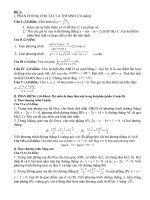Tài liệu Chương 3: Cơ cấu lãi suất pptx
Bạn đang xem bản rút gọn của tài liệu. Xem và tải ngay bản đầy đủ của tài liệu tại đây (357.17 KB, 40 trang )
1
Chapter 3
Structure of Interest Rates
Financial Markets and Institutions, 7e, Jeff Madura
Copyright ©2006 by South-Western, a division of Thomson Learning. All rights reserved.
2
Chapter Outline
Characteristics of debt securities that
cause their yields to vary
Explaining actual yield differentials
Estimating the appropriate yield
A closer look at the term structure
International structure of interest rates
3
Characteristics of Debt Securities
Credit (default) risk
Securities with a higher degree of risk have to offer
higher yields to be chosen
Credit risk is especially relevant for longer-term
securities
Investors must consider the creditworthiness of the
security issuer
Can use bond ratings of rating agencies
The higher the rating, the lower the perceived credit risk
Ratings can change over time as economic conditions
change
Ratings for different bond issues by the same issuer can vary
4
Characteristics of Debt Securities
(cont’d)
Credit (default) risk (cont’d)
Rating agencies
Moody’s Investor Service and Standard and Poor’s
Corporation are the most popular
Agencies use different methods to assess the
creditworthiness of firms and state governments
A particular bond issue could have different ratings from each
agency, but differences are usually small
Financial institutions may be required to invest only in
investment-grade bonds rated Baa or better by Moody’s
and BBB or better by Standard and Poor’s
5
Characteristics of Debt Securities
(cont’d)
Ratings Assigned by:
Description of Security Moody’s Standard and Poor’s
Highest quality Aaa AAA
High quality Aa AA
High-medium quality A A
Medium quality Baa BBB
Medium-low quality Ba BB
Low quality (speculative) B B
Poor quality Caa CCC
Very poor quality Ca CC
Lowest quality (in default) C DDD, D
6
Characteristics of Debt Securities
(cont’d)
Credit (default) risk (cont’d)
Shifts in credit risk premiums
The risk premium corresponding to a particular
bond rating can chance over time
Accuracy of credit ratings
In general, credit ratings have served as
reasonable indicators of the likelihood of default
Credit rating agencies do not always detect
financial problems of firms
7
Characteristics of Debt Securities
(cont’d)
Liquidity
Liquid securities can be easily converted to
cash without a loss in value
Short-maturity securities with an active secondary
market are liquid
Securities with lower liquidity have to offer a
higher yield to be preferred
8
Characteristics of Debt Securities
(cont’d)
Tax status
Investors are more concerned with after-tax income
than before-tax income
Taxable securities have to offer a higher before-tax yield
to be preferred
The after-tax yield is equal to:
)1( TYY
btat
−=
9
Characteristics of Debt Securities
(cont’d)
Tax status
Computing the equivalent before-tax yield
The before-tax yield necessary to match the after-tax yield
on a tax-exempt security is:
State taxes should be considered along with federal taxes
)1( T
Y
Y
at
bt
−
=
10
Computing the Equivalent
Before-Tax Yield
Assume a firm in the 30 percent tax bracket is
aware of a tax-exempt security that pays a yield
of 9 percent. To match this after-tax yield,
taxable securities (with similar maturity and
risk) must offer a before-tax yield of:
%86.12
)3.1(
%9
)1(
=
−
=
−
=
T
Y
Y
at
bt
11
Characteristics of Debt Securities
(cont’d)
Term to maturity
The term structure of interest rates defines the relationship
between maturity and annualized yield
Special provisions
A call feature allows the issuer of bonds to buy the bonds
back before maturity
The yield on callable bonds should be higher than on noncallable
bonds
A convertibility clause allows investors to convert the bond
into a specified number of common stock shares
The yield on convertible bonds is lower than on nonconvertible
bonds
12
Explaining Actual Yield Differentials
Yield differentials are often measured in basis
points
100 basis points equal 1 percent
Yield differentials of money market securities
Commercial paper rates are higher than T-bill rates
Eurodollar deposit rates are higher than yields on
other money market securities
Market forces cause the yields of all securities to
move in the same direction
13
Explaining Actual Yield Differentials
(cont’d)
Yield differentials of capital market securities
Municipal bonds have the lowest before-tax yield
After-tax yield is higher than that of Treasury bonds
Treasury bonds have the lowest yield
No default risk
Very liquid
Investors prefer municipal or corporate bonds over
Treasury bonds only if the after-tax yield
compensates for default risk and lower liquidity
14
Estimating the Appropriate Yield
The yield on a debt security is based on the
risk-free rate with adjustments to capture
various characteristics:
Maturity is controlled for by matching the
maturity of the risk-free security to that of the
security of concern
CONDCALLPTALPDPRY
nfn
+++++=
,
15
Computing the Appropriate Yield
A company wants to issue 180-day commercial paper. Six-
month T-bills currently have a yield of 7 percent.
Assume that a default risk premium of 0.8 percent, a
liquidity premium of 0.1 percent, and a 0.2 percent tax
adjustment are necessary to sell the commercial paper
to investors. What is the appropriate yield the company
should offer on its commercial paper?
%1.8
%2.%1.%8.%7
,
=
+++=
+++++= CONDCALLPTALPDPRY
nfn
16
A Closer Look at the Term
Structure
Pure expectations theory
Pure expectations theory suggests that the
shape of the yield curve is determined solely
by expectations of future interest rates
Assuming an initially flat yield curve:
The yield curve will become upward sloping if
interest rates are expected to rise
The yield curve will become downward sloping if
interest rates are expected to decline
17
Sudden Expectation of Higher
Interest Rates
S
1
D
1
i
1
D
2
i
2
S
2
Market for short-term risk-free debt
S
2
D
2
i
2
D
1
i
1
S
1
Market for long-term risk-free debt
18
Sudden Expectation of Higher
Interest Rates (cont’d)
Yield Curve
YC
1
YC
2
19
Sudden Expectation of Lower
Interest Rates
S
1
D
1
i
1
D
2
i
2
S
2
Market for long-term risk-free debt
S
2
D
2
i
2
D
1
i
1
S
1
Market for short-term risk-free debt
20
Sudden Expectation of Lower
Interest Rates (cont’d)
Yield Curve
YC
1
YC
2
21
A Closer Look at the Term
Structure (cont’d)
Pure expectations theory (cont’d)
Algebraic presentation
The relationship between interest rates on two-year and
one-year securities is:
The one-year interest rate in one year (the forward
rate) can then be estimated:
)1)(1()1(
111
2
2
rii
ttt +
++=+
1
)1(
)1(
1
2
2
11
−
+
+
=
+
i
i
r
t
t
t
22
Computing the Forward Rate
Assume that the annualized two-year interest rate today is
8 percent. Furthermore, one-year securities currently
offer an interest rate of 5 percent. What is an estimate
of the forward rate?
%09.11
1
05.1
08.1
1
)1(
)1(
2
1
2
2
11
=
−=
−
+
+
=
+
i
i
r
t
t
t
23
A Closer Look at the Term
Structure (cont’d)
Pure expectations theory (cont’d)
Algebraic presentation (cont’d)
The one-year interest rate in two years (the forward
rate) can also be estimated:
1
)1)(1(
)1(
111
3
3
12
−
++
+
=
+
+
ri
i
r
tt
t
t
24
Computing the One-Year Interest
Rate Two Years from Now
Continuing with the previous example, assume that three-
year securities currently offer an interest rate of 10
percent. What is an estimate of the one-year interest
rate that will prevail two years from now?
%11.14
1
)1109.1)(05.1(
10.1
1
)1)(1(
)1(
3
111
3
3
12
=
−=
−
++
+
=
+
+
ri
i
r
tt
t
t
25
A Closer Look at the Term
Structure (cont’d)
Pure expectations theory (cont’d)
Algebraic presentation (cont’d)
Future annualized interest rates for periods other than
one year can also be computed using the yield curve
A one-year investment followed by a two-year
investment should offer the same yield as a three-year
security:
( )
)1(
)1(
1
1
3
3
2
21
i
i
r
t
t
t
+
+
=+
+









